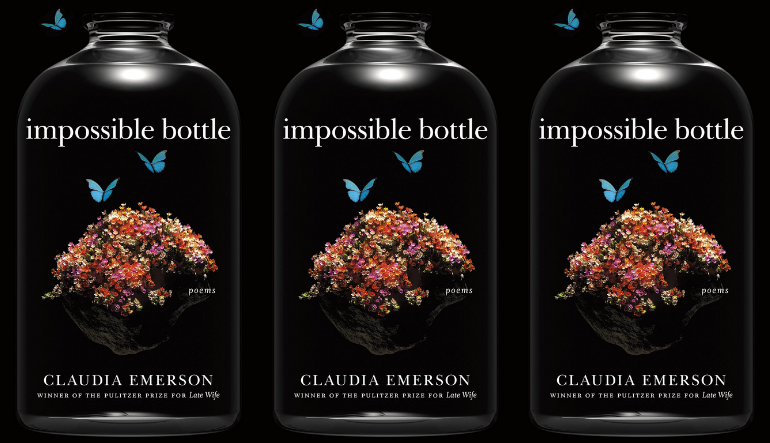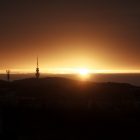L’Appel du Vide: On Visual Caesuras and Erasure
 I take the five students of my poetry micro-workshop outside to discuss Claudia Emerson’s latest collection Impossible Bottle. As we sit in the sun, bending over the brilliant bright book pages, a student points to the poem “Metastasis: Web” and volunteers to read it aloud before our analysis of the author’s craft choices. You—join us. Lend your voice to the poem too. It’s meant for the ear.
I take the five students of my poetry micro-workshop outside to discuss Claudia Emerson’s latest collection Impossible Bottle. As we sit in the sun, bending over the brilliant bright book pages, a student points to the poem “Metastasis: Web” and volunteers to read it aloud before our analysis of the author’s craft choices. You—join us. Lend your voice to the poem too. It’s meant for the ear.
Metastasis: Web
no mistake this web’s expanse
near invisible
in cornered light the screened porch-door
open year round the world’s
entrance to it the wren’s
discovery the accident
the web become larder the spider
grocer its lovely apron
filament parcels of the air
asleep and bound and you
approve somehow of the commerce
as though agreed to
the ease of deft return the joy
such swift excision
(“Metastasis: Web” is used with permission of Louisiana State University Press)
Thank you. How quickly did you read the poem? Did you pause in the middle of lines? Where? Did you read through the lines for the syntax, as we’re taught? Or did you end every line, every break as if it’s a question? (Poet voice, ahem.)
“What do you notice immediately?” I ask, and first, having just heard the poem aloud, they say the sounds—the es hiss at the opening, the chiming vowels of the second half (“air / asleep,” “you // approve somehow”—and then, they say, form. Couplets, no punctuation. And those gaps in the lines! “Why are there gaps?” one students says. “I noticed it throughout the book.”
And I’m so used to this question now, as there hasn’t been a single poetry class I’ve taught recently without a poem that contains those gaps, the visual caesuras (or, as I sometimes call them, in-line white space). In general, I propose a few possibilities, some of which are motivations I’ve had for using the visual caesuras in my own poems.
The author wants to suggest an absence or loss of something or someone, or something isn’t being said.
there’s gaps something
about gin, another thing about
fucking up property, people,
other loves, just fucking leaving Grandma
& the house
(Nate Marshall, “Granddaddy was the neighborhood”)
Ruin: girl’s ghost, her train. In my cave swallows
spit from bright mouths, making. My ear
holds something lush like court in its golden church
as I do remember holding you. I remember every
blackout I—am stories gone. A proof sink, cavalier
scene, ruin or ghost train. A cave spit bright, making
my ear hold lush court. Gold church, I remember you,
my every. O, I remember nothing
better than bastards.
(Lo Kwa Mei-en, “Romance with Blackout”)
The author parses out the syntax or chunks together ideas/phrases/units of meaning without the totalitarian rule of punctuation.
This was Texas a man’s world but women raised these men out of cotton
out of dust Bred longhorns and bullshit She could shoot but she didn’t
She said Sing it baby Please, please— I got down on my knees
(Vievee Francis, “Say It, Say It Anyway You Can”)
The author wants to control the cadence, pace, and sound of the poem, so that the reader is stalled or, conversely, sped up by the white space, or the author like a composer of wind instruments establishes an allegiance to breath, or the author illuminates internal rhymes/chimes/sounds across lines through their visual alignment. This one is a little harder to demonstrate quickly, but here are a few examples for which the writers might be said to use these strategies in their employment of visual caesuras.
i could sense the dear worms
through the grillwork fence,
twists & coils of flexi-script, remaking
the soil by resisting it …
(Brenda Hillman, “Describing Tattoos to a Cop”)
When does he leave again? When he leaves,
I leave. I like that river the sky.
(Jean Valentine, “A Child’s Drawing, 1941”)
I think // His god is not a god like mine / His god
Is not a mother not a father
not a hunter not a farmer
his / God is a stranger
(Shane McCrae, “His God”)
All of the the reasons for having a visual caesura are also reasons one might include a line break, and so the visual caesura might cynically be said to be like having a line break and eating it too. With the Emerson poem, I feel as if I could make a good case for almost all of these approaches. I think most poets don’t sit down trying to unpack the logic of it; it’s an intuitive choice, a kind of I-don’t-know-why-but-I-must decision. But then a student says, “Okay, I might be wrong about this, but could it be that the white space is there more to draw someone in, kind of like it’s a chasm one”—perhaps the eye, I think—“falls into?”
L’appel du Vide. Literally, the call of the void. More generally, it refers to that urge—that shoulder devil voice—telling one jump on the edge of a great gulf, cliff, or highrise. Perhaps then, the visual caesura likewise functions to remind us of some instinctual primacy, the informality of the body, the drama of heights, of depths, of falling. It’s that freefall drop demanding us to ask, Where will I land? Will I survive this leap? Is there a safety net below?
The idea that one can perhaps capture or, rather, render absence, breath, the unsaid is perhaps the reason why the literary community has also become increasingly interested in erasure. Erasure, either by choice or happenstance, offers us a direct engagement with loss, the loss of the text itself. Erasures relies on both what is and isn’t said, as well as its visual revelaton to create meaning for us. We’re as much drawn by the text that appears as the text that doesn’t appear. Solmaz Sharif, in discussing erasure as both a function of both poetry and the state (think declassified and redacted government documents), writes, “the proliferation of erasure as a poetic tactic in the United States is happening alongside a proliferation of our awareness of it as a state tactic . . . when it comes to erasure, this very form of palimpsest, the ghost is not only death or the degradations of time—the ghost is the state itself.” What is blacked out or covered over is what is perhaps most revealing, even dangerous.
Last month, I created an erasure text from Calvino’s Invisible Cities I called Sap, a shortened form of Eusapia, one of the cities of the dead. For me, the void in the text is both what has been blacked out and what hasn’t been blacked out. The words feel as much like empty space as the black paint. Those emptinesses create a space for us to fall into.
About Author
Emilia Phillips is the author of three poetry collections from the University of Akron Press, most recently Empty Clip (2018), and four chapbooks, including the forthcoming Hemlock (Diode Editions, 2019). Her poems and lyric essays appear widely in literary publications including Agni, American Poetry Review, Ploughshares, Poetry, and elsewhere. She’s an assistant professor in the MFA Writing Program and the Department of English at the University of North Carolina at Greensboro.


